About
Many players and fans would agree that Women's Lacrosse is a complex yet beautiful game that anyone can not only appreciate but also love. The following is a brief description of the game, however, to get the best understanding, I highly recommend watching a game, or asking any of our Executive Board members any questions you have. Check out the game schedule for the current season here.
Women's lacrosse is a non-contact game played by 12 players; a goalie, a center, defense (point, cover point, 3rd man, and 2 defensive wings), and offense (1st home, 2nd home, 3rd home, and 2 attack wings).
Women's lacrosse begins with a draw, which is taken by the center on each team. In the draw, the ball is placed between two horizontally held crosses at the circle in the middle of the field. At the sound of the whistle, the ball is flung into the air as the crosses are pulled up and away. A draw is used to start each half and after each goal. Each team is allowed one timeout per half.
When a whistle blows, all players must stop in place. When a ball is ruled out of play, the team that last touched the ball will lose possession. However, if a player takes a shot on goal misses the net, and the ball goes out of bounds, the team closest to the ball will gain possession.
Another key part of lacrosse is the Restraining Line. The Restraining line, as shown below, is 30 yards from the end line on both sides of the field. At anytime, one team may only have 7 players between this restraining line and its nearest end line. If more go over than allowed, off-sides occurs, and the other team gains possession.
An offensive player may never make purposeful contact with a defender, such as running into the defender, even though a clear path was issued, or the defender had been there first, also known as an offensive foul. Rough checks and/or contact to the body with the crosse and/or body, are not allowed.
The defense always needs to be within a stick's length away from their offensive mark while the defender is inside the 8-meter arc (shown below). Only the goalie is allowed in the crease. If any player from either team goes in the crease, possession goes to the opposite team, however, if the goalie comes out, one player from that same team may enter the crease to get the ball (which may have been left on the back of the net).
The 3 second rule applies to the defense; A defender must remain within a stick's length while in the 8-meter arc, and if they stray more than that distance away from their offender, they have 3 seconds to get back in position. If a foul is committed by the defense inside that 8-meter arc, the offensive player to whom the foul was done goes on the closest "hash". The defensive player lines up on the 12-meter arc accordingly. In fact, whenever a major foul is committed anywhere on the field, the foul committer always lines up 4 yards behind the person on which they committed the foul.
Checking is another key part of the game of Lacrosse. Checking is the method by which a player knocks the ball from an opponent's stick. The defender may check the "head" of the stick, and in certain circumstances, the end of the stick if the offender's hands are too close together. The person with possession of the ball in their stick has a "sphere" of about 6 inches around the head in which a defender is not allowed to place their stick.
One more rule to keep in mind is that when the ball is on the ground, no one may "cover" the ball with their stick. Also nobody is allowed to cover anyone else's stick with their stick. There are actually many more rules to the complicated yet exquisite game of Lacrosse, and if you are looking for a Rule Book, please refer to the US Lacrosse Website.
Women's Lacrosse Positions:
THE ATTACK:
- First Home:
- The first home's responsibility is to score. Located in front of the goal, the first home must continually cut toward the goal for a shot, or cut away from the goal to make room for another player. She should have excellent stick-work.
- Second Home:
- The second home is considered the playmaker. She should be able to shoot well from every angle and distance from the goal.
- Third Home:
- The third home's responsibility is to transition the ball from defense to attack. She should be able to feed the ball to other players and fill in wing areas.
- Attack Wings (A-wings):
- The wings are also responsible for transitioning the ball from defense to attack. Wings should have speed and endurance and be ready to receive the ball from the defense and run or pass the ball.
THE DEFENSE:
- Point:
- The point's responsibility is to mark first home. She should be able to stick check, body check and look to intercept passes.
- Cover-point:
- The cover-point's responsibility is to mark second home. She should be able to receive clears, run fast and have good footwork.
- Third Man:
- The third man's responsibility is to mark third home. She should be able to intercept passes, clear the ball, run fast and have good footwork.
- Center:
- The center's responsibility is to control the draw and play both defense and attack. She should have speed and endurance.
- Defense Wings (D-wings):
- The wings are responsible for marking the attack wings and bringing the ball into the attack area. Wings should have speed and endurance.
- Goalkeeper:
- The goalkeeper's responsibility is to protect the goal. She should have good stick-work, courage and confidence.
THE FIELD:


